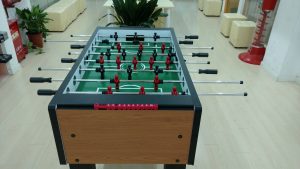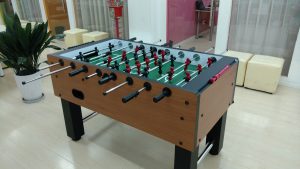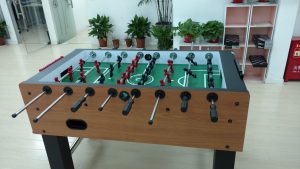 Getting Hooked: No Spinning Allowed
Getting Hooked: No Spinning Allowed
This chapter is intended for those who have little or no experience in Foosball at all, or for those who wish to “teach” others who have little or no experience.
If you’re reading this, you’ve probably encountered good players, perhaps so good you didn’t even dream that this “game” could be taken so seriously. But it is great fun, and you’re probably also on your way to getting hooked. This is the most important part; take the sport as fun, and never be discouraged by any silly, competitive attitudes you may run across when playing other “good” players. Whether you want to learn how to beat these people, or simply ignore them and just have fun with your friends, it will benefit you to learn more about the sport.
The main goals which will be discussed are:
- Discovering what is possible
- Learning basic skills
- Discovering what to practice (yes, practice)
Let us begin with the first concept: what is possible? First of all, the game consists of putting the ball in your opponent’s goal, and keeping it out of yours– that’s obvious. But there are good and bad ways of accomplishing this. The most common problem is “spinning the rods.” Here are the most often-cited points that are good about spinning the rods:
- you can hit the ball HARD with little or no effort
- you hit the ball more often
- because of 1 & 2, you probably score more often
- this method is fun and energetic
- if you don’t spin, you miss the ball a lot, hit it slowly, score less, and look lame
 REASONS WHY YOU SHOULDN’T SPIN THE RODS:
REASONS WHY YOU SHOULDN’T SPIN THE RODS:
- you can hit the ball about as hard as your spin by practicing a wrist-flick (to be described) in less than a week
- you can easily learn to hit the ball more often than a random spin
- you can accurately aim the ball and score, while a spin-shot is pretty random or only straight and easily blockable by an alert opponent
- you are in position to catch loose balls if you don’t spin, creating more scoring opportunities
- spinning can damage the table (by breaking men, pins/screws, or damaging the rod itself)
- The third and fourth reasons are the most compelling since you’ll score more often, while the first two are just ways of saying, “you get the same benefits as spinning anyways with very little practice.”
So: DON’T SPIN THE RODS.
Now as far as offensive play, how do you get these benefits? This is what is important:
- practicing your wrist-flick
- aiming the ball
Not spinning the rods also helps you on defense, and that will be discussed immediately afterwards.
WRIST FLICK: if you can’t seem to hit the ball very hard (without spinning), how do you do it? First of all, try it with your right hand, since that hand will be doing almost all shooting. Put the ball on the play-field under your front three-man rod, in the center in front of an open goal (lift the defending rods for an open shot). Now, practice hitting the ball as hard as possible straight into the goal from this position– use your middle man and don’t push or pull the rod:
- Stand slightly to the left of the rod, and away from the table
- Hold on to the handle, and don’t let go
- Now, “forget” about both your arm and your hand, and only concentrate on your WRIST
- “Throw” your wrist as hard as you can straight down towards the floor, past the side of the handle, resulting in…
- Your wrist snapping downward– since of course your hand is still gripping the handle, the motion stops as your wrist locks abruptly– this is the wrist flick!
AIMING: set the ball up along the 3-rod as previously. This time, instead of concentrating on speed, consider your control of the aim. Observe that if you hit the ball dead-on, the ball travels straight into the goal. Now change your rod’s position, so that if you swing (wrist flick) straight (without push/pulling the rod), you’ll hit the left 1/4 of the ball. Swing. Notice that the ball angled to the right. Different distances from the edge of the ball produce different angles. Beginning your swing with the front of the man’s toe touching the back of the ball gives you more control than if the toe begins from the air way out from behind the ball. Now try aiming a shot into an undefended goal from every single man on your five-man rod. You can even hit a ball in from the very edge of the table!
Before we go on, let me mention an alternative way of hitting a ball hard, this is called the “open hand”, or “fan” technique. Basically, you cock your rod & men backwards to shoot by rolling the handle clockwise up your palm as you open your hand, fingers toward the floor. As you shoot, you reverse the motion and roll the handle back (counterclockwise) to your fingers, which catch the handle tightly. Done quickly, this open-close motion can result in a very hard shot. Control with the open-hand “fan” is more difficult that a normal wrist-flick, but it can be learned.
 FUNDAMENTALS OF DEFENSE: Again, don’t spin the rods. You can only block an incoming shot if your men are straight down, which they aren’t about 80% time when they’re spinning; yet it’s fairly common for beginners to do this anyways. Why? Because it looks cool, and once in a while, a shot blocked by a spinning rod will immediately become an offensive shot towards your opponents goal– neither of these reasons are compelling. Even if you’re not spinning, don’t get eager to shoot the ball: Stop the ball, then shoot it. ;) Otherwise, you’ll often lose the ball, resulting usually in a possession and a quick goal from your opponent’s dreaded 3-rod.
FUNDAMENTALS OF DEFENSE: Again, don’t spin the rods. You can only block an incoming shot if your men are straight down, which they aren’t about 80% time when they’re spinning; yet it’s fairly common for beginners to do this anyways. Why? Because it looks cool, and once in a while, a shot blocked by a spinning rod will immediately become an offensive shot towards your opponents goal– neither of these reasons are compelling. Even if you’re not spinning, don’t get eager to shoot the ball: Stop the ball, then shoot it. ;) Otherwise, you’ll often lose the ball, resulting usually in a possession and a quick goal from your opponent’s dreaded 3-rod.
So, what else do you do? Your opponent can aim the ball just like you can. Therefore, you want to guard both the STRAIGHT shot, and all ANGLE shots. Remember if you can draw a line from the ball to your goal, that shot is open. Never position your two men (your middle goalie and one of the men on the two-man rod) behind each other– if you do, you’re just blocking the same place twice, and you might as well just lift one of the men, and your defense wouldn’t be any worse for it! Just experiment, placing the ball on all parts along the opposing 3-rod, and positioning your defensive men to block both the straight and angle shots. Remember if you can draw a line from the ball to your goal, that shot is open. (Did I just say that?) Now your opponent either relies on you to flinch and open these holes, or must “race” you, moving the ball horizontally along his three-rod until it reaches a position where a different straight shot (or sometimes the angle) is open. Defending against opponents who try this latter option will be discussed in Chapter 2. Also, be very aware that shots from the opposing 5-rod and 2-rod can also be blocked in this way– you just have to learn to expect a shot from these areas of the table, and block most of the possible “lines” to your goal. Just being aware of these “lines” and trying to block them will make a big difference. Finally, if you’re shooting from the defensive region, remember you can still aim it, and take your time to lift up your 5- and 3-rods (or in doubles, tell your partner) so that you’ll never block your own shot!
WITH WHICH HAND DO YOU HOLD WHICH ROD in singles play?
- When you’re defending against a 3-rod shot, hold BOTH of your defensive rods (goalie & 2-man)– Ditto for when you’re shooting from your defensive region.
- When you’re defending an opponent’s defensive-region shot, you should have your right hand on your 3-rod, and your left either on your 5-rod or goalie-rod; the latter may be more effective at first.
- When the ball is in the center region, you should have your L & R hand on the goalie-rod and 5-rod (maximum defense).
Later, when you learn how to pass and you have possession of the ball, you can stop the ball, and switch to holding the 5-rod and the 3-rod (ready for offense or passing to the 3-rod), and when you get much better, you may wish to stay in this position for defense against the opposing 5-rod or 2-rod, so that you are ready to catch any loose balls on your 3-rod.
BALL-CONTROL (or how not to lose the ball): this is especially for those playing on tables which are not Tornado or Striker, and tables which are old, dented, and otherwise warped. Ball control is much easier on the Tornado and Striker, but the skills in this section are still essential to learn for these tables too. To be able to use your growing arsenal, you need to be able to “maneuver” the ball, and not lose it. There are three exercises which are good to do, all on the 3-rod.
- INTERCEPTION: Try very lightly tapping the front of the ball (with the back of your toe), then as the ball rolls back, tapping the back of the ball (with the front of your toe). Continue to gently tap the ball back and forth; this back-and-forth distance will be less than an inch– the skill being learned here is to rapidly lift the man and swing it around to the other side of the ball to prevent it from rolling away. You will find the shape of the motion to be a series of “C” shapes around the ball.
- PINNING: In the second exercise again begin by tapping one side (front or back) of the ball, but this time let it roll further. Move in the same “C” shape as if to intercept it, but leave your toe lifted in the air. When the ball rolls under your man’s toe, bring it down forcefully on the top surface of the ball to “pin” it to the playing field, resulting in a sudden stop. Practice both versions (i.e. tap back of ball then front-pin; tap front of ball then back-pin). This develops the reflex to suddenly and confidently “catch” a ball which is too difficult to intercept by method 1). For example, this “pin” catch is very useful for a ball which is rolling away at high speed.
- BALL MOVEMENT: The third exercise is to pass the ball from one man on the 3-rod to another, steady the ball, and again pass it to the next man on the rod. Continue passing among all three men on the rod. The skill here is maneuvering the ball wherever you wish it to be along your rod. Also try bringing the ball to a stop at various points along the rod. You will find that the skills learned in 1) and 2) are very useful to prevent the ball from rolling away out of reach– try and develop a feel for when it is better to use 1) vs. 2) to retrieve a ball about to roll away from you. These skills of interception, pinning, and ball-movement are applicable to all rods of a Foosball table.
Now that you can wrist-flick hard, aim the ball, know how to act on defense, and know how to maneuver a ball without losing it, you are hereby no longer a “spinner”!
Did you know that if you subscribe to our website, you will receive email notifications whenever content changes or new content is added.
1. Enter your e-mail address below and click the Sign Me Up button.
2. You will receive an email asking you to confirm your intention of subscribing to our site.
3. Click the link in the email to confirm. That’s all there is to it! Note: if you wish to unsubscribe from our site, click the unsubscribe link at the bottom of the email you received.
Then indicate you no longer wish to receive our emails.
Thank You
Dialect Zone International